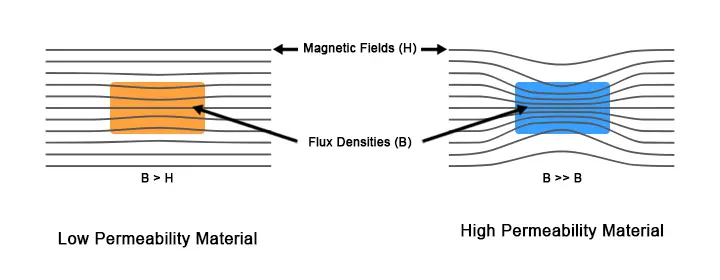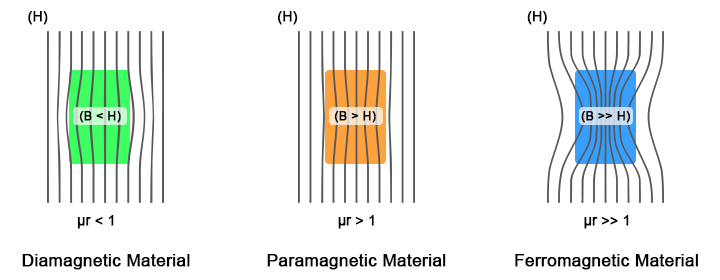Magnetic Permeability
What is Magnetic Permeability
Magnetic permeability, denoted by the letter (μ) "Mu," measures the ability of a material to form an internal magnetic field and becomes magnetized when exposed to an external magnetic field.
When a material is subjected to an external magnetic field, a material with high permeability will form a strong internal magnetic field, and a material with low permeability will form a weak internal magnetic field. See below

After looking at the previous diagram, we can say that permeability is the ability of a material to attract magnetic field lines to it. The more magnetic field lines a material can attract, the higher its permeability and the easier it can be magnetized, and vice versa.
Permeability of a material is affected by several factors, such as the type of the material, humidity, its position in the applied magnetic field, temperature, and frequency of the applied field.
Relative Permeability and Vacuum permeability
Relative permeability (μr) is the ratio between the permeability of a specific material and the permeability of vacuum.
The vacuum permeability (μo) is the permeability value of absolute vacuum, which is equal to 1.257x10-6 henries per meter.
Vacuum permeability is commonly referred to as the permeability constant, magnetic constant, or permeability of free space.
Diamagnetic, Paramagnetic, & Ferromagnetic Materials

We can classify materials on the basis of their permeability into three categories:
- Diamagnetic, when a diamagnetic material is subjected to an external magnetic field, it produces an internal field in the opposite direction of the external field, which causes the magnetic flux density inside of it to be slightly reduced. This fact makes a diamagnetic material rebel from the magnetic field. Examples of diamagnetic materials are water, mercury, silver, and bismuth. (Diamagnetic materials have a relative permeability that is slightly less than 1).
- Paramagnetic, when a paramagnetic material is subjected to an external magnetic field, it produces an internal field in the same direction as the external field, which causes the magnetic flux density inside of it to be slightly increased. This fact makes a paramagnetic material attracted to the magnetic field. Examples of paramagnetic materials are oxygen, lithium, aluminum, and titanium. (Paramagnetic materials have a relative permeability that is slightly more than 1).
- Ferromagnetic, when a ferromagnetic material is subjected to an external magnetic field, it produces a very strong internal field in the same direction as the external field, which causes the magnetic flux density inside of it to be highly increased. This fact makes a ferromagnetic material very attracted to the magnetic field. Examples of ferromagnetic materials are iron, cobalt, nickel, and gadolinium. (Ferromagnetic materials have a varying relative permeability that changes depending on the strength of the magnetic field, and in some alloys can reach 100,000 or even more).
Formula & Units
Where:
- µ is the magnetic permeability
- B is the flux density, volt second per square meter (Teslas)
- H is the magnetizing field, ampere per meter (A/m)
The SI unit of permeability is henries per meter (H/m), or newtons per ampere squared (N/A2).
Where:
- µr is the relative magnetic permeability
- µ is the magnetic permeability of the material
- µo is permeability of free space
The relative magnetic permeability is unitless, as it’s the ratio between two similar quantities.
Factors Affecting Magnetic Permeability
The magnetic permeability of a material can be affected by several factors, including:
- Composition: The composition of a material is the most significant factor that affects its magnetic permeability. Materials that contain iron, nickel, and cobalt have high permeability because of their ability to align their magnetic moments in the presence of an external magnetic field.
- Temperature: Temperature can affect the magnetic properties of a material, which in turn can affect its permeability. For example, at high temperatures, the magnetic moments of a material may become disordered, leading to a decrease in its permeability.
- Physical Properties: The physical properties of a material, such as its crystal structure, grain size, and defects, can also affect its magnetic permeability.
- Frequency: The frequency of the applied magnetic field can also affect the permeability of a material. Some materials have higher permeability at low frequencies but lower permeability at high frequencies.
Understanding the factors that affect magnetic permeability is essential for designing and developing magnetic materials for specific applications. By controlling the composition, temperature, and other physical properties of a material, its magnetic permeability can be optimized for a particular application.
Applications of Magnetic Permeability
Magnetic permeability is a fundamental property of materials that has several practical applications in many fields. Some of the common applications of magnetic permeability include:
- Magnetic shielding: Materials with low permeability, such as mu-metal, are used in magnetic shielding to protect sensitive equipment from external magnetic fields.
- Magnetic storage: The magnetic permeability of materials is used in magnetic storage media, such as hard drives and magnetic tapes, where the magnetic properties of the material are used to store and retrieve data.
- Magnetic resonance imaging (MRI): Magnetic permeability plays a crucial role in MRI, where the magnetic properties of tissues and organs are used to create detailed images of the body.
- Electromagnetic devices: Magnetic permeability is essential in designing and developing electromagnetic devices, such as electric motors, generators, and transformers.
- Magnetic sensors: Magnetic permeability is used in magnetic sensors, such as magnetic field sensors and Hall-effect sensors, that detect magnetic fields and measure magnetic properties of materials.
Magnetic Permeability Summary | |
|---|---|
| Definition | The measure of a material’s ability to form an internal magnetic field when subjected to an external field. |
| Symbol | |
| Formula | |
| Units | SI unit (H/m) |
Frequently Asked Questions
- Does magnetic permeability change with temperature?
- Yes, magnetic permeability can change with temperature. The degree and direction of this change depend on the material’s properties and the temperature range. In general, the magnetic permeability of ferromagnetic materials decreases with increasing temperature, while the magnetic permeability of paramagnetic and diamagnetic materials increases with increasing temperature.
- What is the unit of magnetic permeability?
- The SI unit of magnetic permeability is henries per meter (H/m), or newtons per ampere squared (N/A2).
- What is the magnetic permeability of free space?
- The magnetic permeability of free space or vacuum is a physical constant, and it’s equal to 4πx10-7 N/A2.
